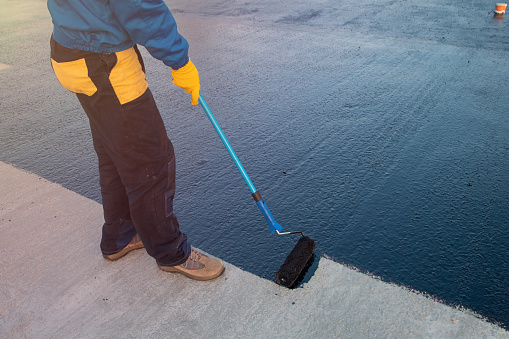Coating your roof is essential to maintaining the roof’s longevity and integrity. An adequate roof coating protects your roof from weathering and water damage.
However, applying roof coatings can be challenging, and people tend to easily make costly mistakes when it comes to a roof coating. In this article, we’ll intend to discuss some of the most common roof coating mistakes to avoid.
Continue reading to discover what these mistakes are.
What Is Roof Coating?
A roof coating is a special paint or sealant that roof professionals usually use to cover a roof’s surface. Roof coating generally helps to protect your roof from weather elements, like rain, wind, and sunlight, that may cause damage to it over time.
Applying roof coating is like fortifying your roof with an extra layer of protection that can help it last longer. Therefore, you consider roof coatings important if you stay in an area with very harsh weather conditions, such as heavy rain or hot sunshine.
Roof coatings can also help to reflect heat away from your roof’s surface. This can have a resultant effect that helps make your home’s interior feel cooler and more comfortable.
Overall, roof coatings are a great way to keep your roof in good shape and save money on roof repairs.
Common Roof Coating Mistakes to Avoid
Here are some common roof-coating mistakes that you should try to avoid:
1. Not preparing the surface properly
It’s important to properly clean the surface of the roof you want to coat before you start the roof coating process. You must wipe away dirt, grime, and residue and ensure the surface is dry.
Experts usually recommend washing the roof surface with Acu-Wash. You can use a roto spray tip while pressure washing the roof’s surface. Afterward, you should thoroughly rinse the roof before you start coating it.
If you do not carry out the cleaning and drying procedures as required, the coating may not stick on the roof properly. The result is that the coating process would have wasted time and effort.
2. Using the wrong type of coating
Not all roofs use the same type of coating. Different types of roofs require different types of coatings. Due to this factor, you need to use a coating specifically designed for your roof type. If you use the wrong type of coating, the coating may not offer adequate protection to your roof or even cause damage.
3. Skipping the primer
Primers are a special kind of coating that roofing professionals usually apply before they apply the main roof coating. The primer helps to establish a better bond between the roof and the main coating.
Consequently, the better bond between the primer and the main coating help to improve the overall performance of the coating. If you properly apply the primer or apply it, the bond between your roof and the coating may be stronger.
It may directly weaken your roof over time and bring damage to it after a while.
4. Applying the coating too thick or too thin
Ensure to apply the coating is in an even and consistent manner. Applying the coating very thickly may cause heavy patches, leading to structural problems.
You should also be wary of making the coating too thin because when you make it too thin, the coating fails to protect the roof properly.
5. Not allowing enough drying time
Not all coating takes the same amount of time to dry up completely. Some coatings take longer to dry up than others. Hence, you must follow the manufacturer’s recommendations and give the coating enough time to dry up.
6. Applying before rainstorms
Though the weather is not something you can accurately predict every time, you should pick a duration with the less likely occurrence of rainfall. The best time for carrying out your roof coating project is in a week when there is little chance of the likelihood of rainfall. Ensure to apply the roof coating in two layers. Each of these layers needs to dry up completely before you apply the next. If rain falls when it shouldn’t, it could wash every coating material in a particular layer away.
Unfortunately, this will end up defeating the purpose of the coating in the first place. Additionally, applying the coating early in the day is more advisable. Applying the coating too close to dusk could leave the coating vulnerable to moisture from dew.
Consider the environmental factors surrounding where you reside. The roof coating will naturally take longer to dry in low-temperature, high-humidity areas than in high-temperature, low-humidity areas.
7. Not properly sealing the seams, flashings, and fasteners
Some roofers often omit this important roof coating procedure. It is very important to ensure that you properly seal every seam, flashing, and fastener after cleaning the roof and leaving it to dry. You can try out Acu-Caulk and Acu-Fabric for this kind of task.
The above materials produce an almost unbreakable barrier that resembles a bandage. In addition to the above tools, Acu-Tape is another useful tool for sealing seams and flashings.
8. Using Roof Coats as an Overall Roofing Solution
Never think of roof coatings as a solution for every issue a commercial roof might have. You must first conduct inspections to determine the state of the roofing system.
After conducting inspections, you can determine whether using them will help lengthen your roof’s service life. If there are issues on at least one-fourth of your roof, you may need to hire roofing professionals.
Conclusion
You can easily avoid the common mistakes associated with roof coating as long as you employ the services of a professional roof contractor.
At RoofPro, we are an experienced roofing company that can provide you with the help you need for your roof coating. Call us at 250-248-3400 or fill out our online contact form to book a consultation session.


